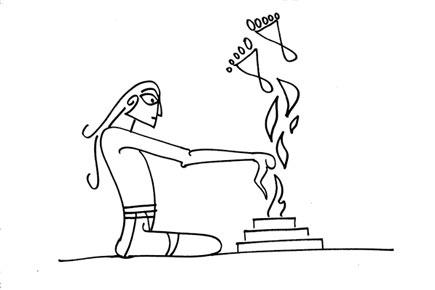People refer to the Vedas rather loosely, often forgetting how old they are and the vast period over which this knowledge came together

Opinion, Columnists, Devdutt Pattanaik, Devlok, Vedas, Veda, Vedanta, Mythology
 People refer to the Vedas rather loosely, often forgetting how old they are and the vast period over which this knowledge came together.
People refer to the Vedas rather loosely, often forgetting how old they are and the vast period over which this knowledge came together.
Veda means knowledge. It refers to a vast body of literature that emerged over a thousand years. Vedanta literally means ‘end of the Vedas’ or ‘pinnacle of the Vedas’. It refers to wisdom gleaned out of the Veda. The journey from Veda to Vedanta occurred over two thousand years starting from 2,000 BC.
ADVERTISEMENT
The earliest hymns of the Rig Veda are at least 4,000 years old. Some hymns refer to astronomical events that took place 8,000 years ago. These hymns invoked and praised gods (devas) who embodied natural forces like fire, sun and various celestial bodies, while expressing a yearning for an abstract powerful unifying force called Brah-mana. These were not written at one time.

Illustration / Devdutt Pattanaik
Around 3500 years ago, the Sama Veda bound the hymns of the Rig Veda to melodies while Yajur Veda bound the same hymns to ritual. The Brahmana texts elaborated on the connection between the hymns and the ritual choreography. In the Yajur Veda, we find Brah-mana was seen as permeating the ritual itself.
Around 3,000 years ago, greater attention was paid to the mind of the performer and in the Upanishads, Brah-mana was identified as the expanded mind that can experience infinity (an-anta). The words karma and atman start appearing with unfailing regularity.
From the Rig Veda to the Upanishads, we find a shift in focus from the outside to the inside: from the gods in the stars, through the ritual, to the mind of the performer.
The psychological journey from Rig Veda to the Upanishads was accompanied by a physical journey of people from the upper tributaries of the Indus in the West to the lower branches of Ganga in the East. It witnessed the older nomadic pastoral lifestyle giving way to a more settled agricultural lifestyle.
The portable ritual, the yagna, favoured the nomadic lifestyle. It involved setting up a brick altar, invoking the gods (devas) who lived in the sky using hymns and fire, and finally setting the sacrificial precinct aflame when it was time to move.
With settlement, the gaze shifted to the earth, to the confluence of rivers and the peaks of mountains, as tribes and clans mingled and merged to form villages, and villages became part of kingdoms and empires. Responsibilities of farm and family entrapped erstwhile wanderers.
Suddenly there was prosperity, and issues of property, inheritance, and disputes over division of wealth leading to war. Division of labour created hierarchies. A new kind of discourse was needed. The Vedic way had to be reframed to suit the new reality. Hence, Vedanta, which spoke of what is self and what is not self, of mine and not mine, of measurements and divisions, of delusions and reality that leads to war.
Parallel to the rise of Vedanta, we find the arrival of Buddhism, and other monastic orders that reject worldly life. Parallel to it is also the rise of kings — of Mauryans, who wanted to establish an empire, mimicking the Persian King and the Greek adventurer who dethroned him — Alexander. The symbol of sages who conquered the mind, and kings who conquered the land, was the same — the lion!
The author writes and lectures on relevance of mythology in modern times, and can be reached at devdutt@devdutt.com
The views expressed in this column are the individual’s and don’t represent those of the paper.
 Subscribe today by clicking the link and stay updated with the latest news!" Click here!
Subscribe today by clicking the link and stay updated with the latest news!" Click here!







